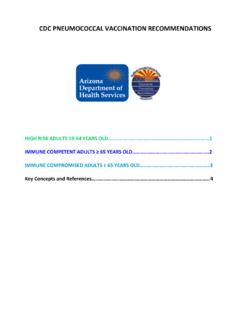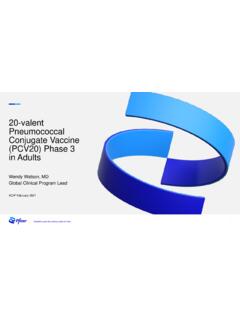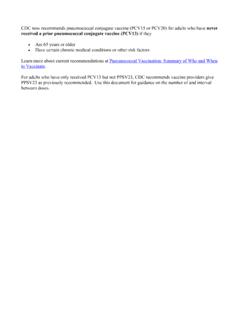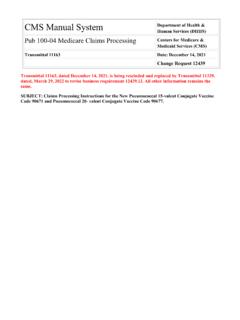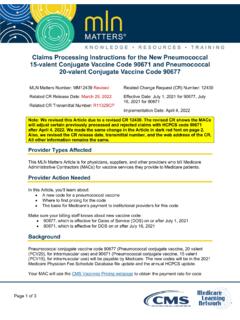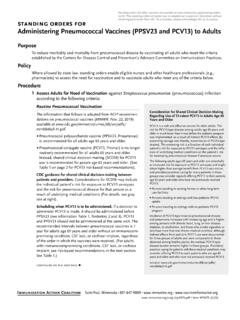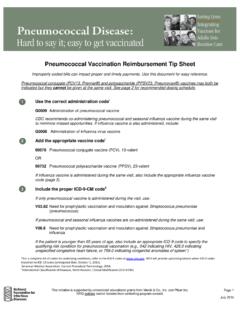Transcription of Patient Group Direction for Pneumovax II (23-Valent ...
1 1 Patient Group Direction for Pneumovax II 23-Valent pneumococcal Vaccine October 2014 Document Title: Patient Group Direction for Pneumovax II (23-Valent pneumococcal Vaccine (PPV)) Area Team Ref.: PGD Version No.: 7/2014 NHS Doc Ref.: Author: Hitesh Patel Pharmaceutical Adviser Owner: Rebecca Woods, Head of Public Health Commissioning File Reference: I:\NHS_ENGLAND\AngleseyHouse\Commissioni ng Directorate\Primary Care & Specialised Commissioning\Public Health\Immunisation\2014-15\10) PGDs\Approved Owner: Rebecca Woods, Head of Public Health Commissioning Document Overseeing Group : PGD Working Group Placement in Framework: Approval Level: Medicines Management Committee Date of Approval: November 2014 Review Date: November 2016 Amendment Dates.
2 Page(s) Brief Description October 2014 Updated to new PGD format 2 Patient Group Direction for Pneumovax II 23-Valent pneumococcal Vaccine October 2014 Please note: There are 2 pneumococcal vaccines, this PGD applies to the 23-valent unconjugated pneumococcal polysaccharide vaccine (PPV) only. There is a separate PGD relating to pneumococcal conjugate vaccine (PCV) which is intended for use in children under 5 years of age. Approved By NHS England and Staffordshire Area Team Name Signature Medical Director Dr Ken Deacon LPN Pharmacy Chair Dr Manir Hussain Head of Public Health Commissioning Rebecca Woods Date of Patient Group Direction approved Nov 2014 Date this Patient Group Direction becomes due for review Nov 2016 or in response to new local/national guidelines.
3 Patient Group Direction for administration of Pneumovax II (23-Valent pneumococcal polysaccharide) (PPV) 3 Patient Group Direction for Pneumovax II 23-Valent pneumococcal Vaccine October 2014 STAFF CHARACTERISTICS Provider of NHS services within NHS England (Shropshire & Staffordshire Area Team) Registered nurse with current NMC registration Specialist competencies or qualifications: The health care professional must have a good understanding of the NICE Good Practice Guidance on Patient Group Directions. The NICE competency framework: For health professionals using Patient Group Directions should be used by health care professionals planning to work under this PGD to identify any gaps in their knowledge.
4 The gaps should be addressed before the healthcare professional is authorised to work under this PGD. The clinical manager/ lead GP/commissioner must have evidence that the health care professional has undertaken training to carry out clinical assessment of Patient leading to confirmation that the Patient requires treatment according to the indications listed in the PGD. The healthcare professional must provide evidence of training, appropriate annual updates and continued professional development undertaken to support their competence for administration of this treatment.
5 The clinical manager/ lead GP must have assessed the competency of the healthcare professional to work to this Patient Group Direction . The NICE competency framework: For health professionals using Patient Group Directions should be used to support this assessment. The health care professional must have undertaken training and annual updates in the recognition and treatment of anaphylaxis, including practical in Basic Life Support and has immediate access to an in-date supply of adrenaline 1mg in 1ml (1:1000) at the time of the consultation. (The practitioner must be deemed competent in basic life support and in emergency administration of adrenaline) The health care professional must have access to all relevant sources of information information issued by the Department of Health (Green Book), British National Formulary (BNF), Summary of Product Characteristics (SPC), and the clinical guideline concerning medicine(s) within this Patient Group Direction (PGD).
6 The practitioner must be competent and knowledgeable in vaccine cold chain standards. The registered health care practitioner is professionally accountable for supply or administration under the PGD as defined in their own profession s Code of Professional Conduct and Ethics. YOU MUST BE AUTHORISED BY NAME BY YOUR CLINICAL LEAD UNDER THE CURRENT VERSION OF THIS PGD BEFORE YOU ATTEMPT TO WORK ACCORDING TO IT PGDs DO NOT REMOVE INHERENT PROFESSIONAL OBLIGATIONS OR ACCOUNTABILITY 4 Patient Group Direction for Pneumovax II 23-Valent pneumococcal Vaccine October 2014 CLINICAL CONDITION Clinical need addressed Active immunisation against pneumococcal disease in accordance with the national immunisation programme Inclusion criteria Informed consent obtained All those aged 65 years and over.
7 All at risk children (see below) aged 2 years to five years who have received the pneumococcal conjugated vaccine (PCV) in accordance with the PCV PGD All at risk children over 5yrs and adults Clinical Risk Category Examples (decision based on clinical judgement) Asplenia or dysfunction of the spleen This also includes conditions such as homozygous sickle cell disease and coeliac syndrome that may lead to splenic dysfunction Chronic respiratory disease, including asthma This includes chronic obstructive pulmonary disease (COPD), including chronic bronchitis and emphysema and such conditions as bronchiectasis, cystic fibrosis, interstitial lung fibrosis, pneumoconiosis and bronchopulmonary dysplasia (BPD).
8 Children with respiratory conditions caused by aspiration, or a neuromuscular disease ( cerebral palsy) with a risk of aspiration. Asthma is not an indication, unless so severe as to require continuous or frequently repeated use of systemic steroids (as defined in Immunosuppression below). Chronic heart disease This includes those requiring regular medication and/or follow-up for ischaemic heart disease, congenital heart disease, hypertension with cardiac complications, and chronic heart failure. Chronic renal disease Including nephrotic syndrome, chronic renal failure, kidney transplantation.
9 Chronic liver disease This includes cirrhosis, biliary atresia and chronic hepatitis. Diabetes Diabetes mellitus requiring insulin or oral hypoglycaemic drugs. This does not include diabetes that is diet controlled. Immunosuppression Due to disease or treatment, including asplenia or splenic dysfunction and HIV infection at all stages. Patients undergoing chemotherapy leading to immunosuppression. Individuals on or likely to be on systemic steroids for more than a month at a dose equivalent to prednisolone at 20mg or more per day (any age), or for children under 20kg, a dose of 1mg or more per kg per day.
10 However, some immunocompromised patients may have a suboptimal immunological response to the vaccine. 5 Patient Group Direction for Pneumovax II 23-Valent pneumococcal Vaccine October 2014 Individuals with cochlear implants It is important that immunisation does not delay the cochlear implantation Individuals with cerebrospinal fluid leaks This includes leakage of cerebrospinal fluid such as following trauma or major skull surgery. Primary care staff should identify patients for whom vaccine is recommended and use all opportunities to ensure that they are appropriately immunised for example.










